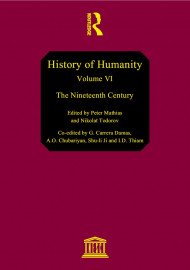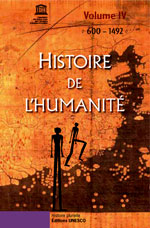DL Services SPRL
Rue Vanderborght 24
1081 Brussels Belgium
info@dl-servi.com
History of humanity: scientific and cultural development, v. VI: The Nineteenth century
Disponible
Each volume of the new UNESCO History of Humanitycovers a period which can claim to have witnessed momentous change in the evolution of human society. The evolving panorama of humankind on the planet is manifest throughout, and who can say, sub specie aeternitatis, which phases of change will have proved the most portentous for the long-term future of humanity? It is the primary role of a history such as this to document the story of change within its period, to understand the pattern of evolution in its manifold manifestations and to assess its wider meaning, rather than to cast moral judgements or to make facile comparisons. But change has evolved at a different pace in different millennia and over different centuries. Change has been more pervasive in some societies than in others – affecting a wider or narrower range of human activities and the human consciousness, impacting upon different levels of society; diffused over greater or more limited regions of the world; inf luencing different ranges of cultures and social groups within cultures. Stability, or slow evolution, rather than dramatic change characterized many societies in this period but it is right, in an introduction, to concentrate on the forces of change rather than those of inertia if we are to understand how the world differed in 1914 from what it had been in 1789 or 1800. The ‘chronological’ nineteenth century – or, even more, the ‘long’ nineteenth century between the French Revolution of 1789, followed by world-wide wars, and the First World War of 1914, which engulfed the globe on an even more pervasive and lethal scale – must surely rank as one of the great pivotal epochs in the evolution of economies, societies and cultures. No region of the world proved to be beyond the inf luence of major forces of change; no culture was immune, directly or indirectly. Where some indigenous cultures did not themselves originate any major impetus for change beyond their own regions, virtually all economies and cultures reacted and responded to the thrust of change derived from beyond their boundaries, in turn inf luencing the process of cultural interaction which was never uni-directional (as was also the case with economic and political interactions). In many places, in regions of Asia and Africa in particular, such inf luences came with conquest and colonization in the nineteenth century; in others such inf luences were already the heritage of and evolution from previous centuries (as in Latin America). But formal subjugation was perhaps the lesser means whereby what was loosely termed ‘Westernization’ spread across much the world from Europe, North America and their outposts of settlement in Austra lasia, South Af rica and North Africa. Each volume of the new UNESCO History of Humanity covers a period which can claim to have witnessed momentous change in the evolution of human society. The evolving panorama of humankind on the planet is manifest throughout, and who can say, sub specie aeternitatis, which phases of change will have proved the most portentous for the long-term future of humanity? It is the primary role of a history such as this to document the story of change within its period, to understand the pattern of evolution in its manifold manifestations and to assess its wider meaning, rather than to cast moral judgements or to make facile comparisons. But change has evolved at a different pace in different millennia and over different centuries. Change has been more pervasive in some societies than in others – affecting a wider or narrower range of human activities and the human consciousness, impacting upon different levels of society; diffused over greater or more limited regions of the world; influencing different ranges of cultures and social groups within cultures. Stability, or slow evolution, rather than dramatic change characterized many societies in this period but it is right, in an introduction, to concentrate on the forces of change rather than those of inertia if we are to understand how the world differed in 1914 from what it had been in 1789 or 1800.
The ‘chronological’ nineteenth century – or, even more, the ‘long’ nineteenth century between the French Revolution of 1789, followed by world-wide wars, and the First World War of 1914, which engulfed the globe on an even more pervasive and lethal scale – must surely rank as one of the great pivotal epochs in the evolution of economies, societies and cultures. No region of the world proved to be beyond the influence of major forces of change; no culture was immune, directly or indirectly. Where some indigenous cultures did not themselves originate any major impetus for change beyond their own regions, virtually all economies and cultures reacted and responded to the thrust of change derived from beyond their boundaries, in turn influencing the process of cultural interaction which was never unidirectional (as was also the case with economic and political interactions). In many places, in regions of Asia and Africa in particular, such inf luences came with conquest and colonization in the nineteenth century; in others such influences were already the heritage of and evolution from previous centuries (as in Latin America). But formal subjugation was perhaps the lesser means whereby what was loosely termed ‘Westernization’ spread across much the world from Europe, North America and their outposts of settlement in Australasia, South Africa and North Africa.
675p., 2008
Génération de facture pro forma disponible dans le panier.


















